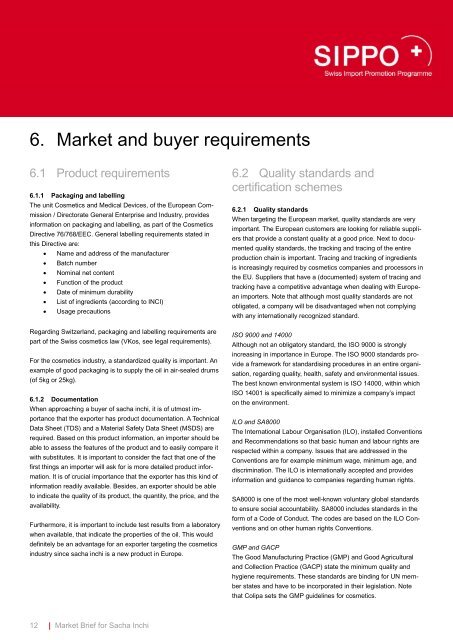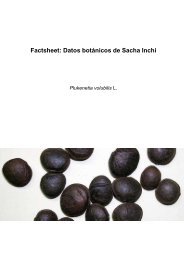Market Brief for Sacha Inchi.
Market Brief for Sacha Inchi.
Market Brief for Sacha Inchi.
Create successful ePaper yourself
Turn your PDF publications into a flip-book with our unique Google optimized e-Paper software.
6. <strong>Market</strong> and buyer requirements<br />
6.1 Product requirements<br />
6.1.1 Packaging and labelling<br />
The unit Cosmetics and Medical Devices, of the European Com-<br />
mission / Directorate General Enterprise and Industry, provides<br />
in<strong>for</strong>mation on packaging and labelling, as part of the Cosmetics<br />
Directive 76/768/EEC. General labelling requirements stated in<br />
this Directive are:<br />
� Name and address of the manufacturer<br />
� Batch number<br />
� Nominal net content<br />
� Function of the product<br />
� Date of minimum durability<br />
� List of ingredients (according to INCI)<br />
� Usage precautions<br />
Regarding Switzerland, packaging and labelling requirements are<br />
part of the Swiss cosmetics law (VKos, see legal requirements).<br />
For the cosmetics industry, a standardized quality is important. An<br />
example of good packaging is to supply the oil in air-sealed drums<br />
(of 5kg or 25kg).<br />
6.1.2 Documentation<br />
When approaching a buyer of sacha inchi, it is of utmost im-<br />
portance that the exporter has product documentation. A Technical<br />
Data Sheet (TDS) and a Material Safety Data Sheet (MSDS) are<br />
required. Based on this product in<strong>for</strong>mation, an importer should be<br />
able to assess the features of the product and to easily compare it<br />
with substitutes. It is important to consider the fact that one of the<br />
first things an importer will ask <strong>for</strong> is more detailed product in<strong>for</strong>-<br />
mation. It is of crucial importance that the exporter has this kind of<br />
in<strong>for</strong>mation readily available. Besides, an exporter should be able<br />
to indicate the quality of its product, the quantity, the price, and the<br />
availability.<br />
Furthermore, it is important to include test results from a laboratory<br />
when available, that indicate the properties of the oil. This would<br />
definitely be an advantage <strong>for</strong> an exporter targeting the cosmetics<br />
industry since sacha inchi is a new product in Europe.<br />
12 | <strong>Market</strong> <strong>Brief</strong> <strong>for</strong> <strong>Sacha</strong> <strong>Inchi</strong><br />
6.2 Quality standards and<br />
certification schemes<br />
6.2.1 Quality standards<br />
When targeting the European market, quality standards are very<br />
important. The European customers are looking <strong>for</strong> reliable suppli-<br />
ers that provide a constant quality at a good price. Next to docu-<br />
mented quality standards, the tracking and tracing of the entire<br />
production chain is important. Tracing and tracking of ingredients<br />
is increasingly required by cosmetics companies and processors in<br />
the EU. Suppliers that have a (documented) system of tracing and<br />
tracking have a competitive advantage when dealing with Europe-<br />
an importers. Note that although most quality standards are not<br />
obligated, a company will be disadvantaged when not complying<br />
with any internationally recognized standard.<br />
ISO 9000 and 14000<br />
Although not an obligatory standard, the ISO 9000 is strongly<br />
increasing in importance in Europe. The ISO 9000 standards pro-<br />
vide a framework <strong>for</strong> standardising procedures in an entire organi-<br />
sation, regarding quality, health, safety and environmental issues.<br />
The best known environmental system is ISO 14000, within which<br />
ISO 14001 is specifically aimed to minimize a company’s impact<br />
on the environment.<br />
ILO and SA8000<br />
The International Labour Organisation (ILO), installed Conventions<br />
and Recommendations so that basic human and labour rights are<br />
respected within a company. Issues that are addressed in the<br />
Conventions are <strong>for</strong> example minimum wage, minimum age, and<br />
discrimination. The ILO is internationally accepted and provides<br />
in<strong>for</strong>mation and guidance to companies regarding human rights.<br />
SA8000 is one of the most well-known voluntary global standards<br />
to ensure social accountability. SA8000 includes standards in the<br />
<strong>for</strong>m of a Code of Conduct. The codes are based on the ILO Con-<br />
ventions and on other human rights Conventions.<br />
GMP and GACP<br />
The Good Manufacturing Practice (GMP) and Good Agricultural<br />
and Collection Practice (GACP) state the minimum quality and<br />
hygiene requirements. These standards are binding <strong>for</strong> UN mem-<br />
ber states and have to be incorporated in their legislation. Note<br />
that Colipa sets the GMP guidelines <strong>for</strong> cosmetics.









